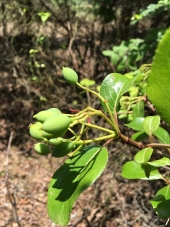I will be getting St. Croix sheep. They are a very hardy hair sheep and from the research I have done, they
should eat the kudzu. As far as getting rid of or controlling kudzu, I have had some success. If you keep it mowed down you can keep it under control. Then to get rid of it, you can chop out the crown of the vine which is just below the surface of the soil. It is the clump that all the vines grow out of. If you get that clump or crown cut out it will not grow back. If the vine has been growing for some time there is a tuber that grows below the crown. You don't have to get that out. It will die. Also, if you get out new plants as they are trying to start, by digging them out below the surface of the soil, they will not come back. It is easy to stop the new plants. It is the bigger old vines that are a lot harder to get out and stop. They can be really tough and hard to dig that crown out. The vines that come out of that main clump have also put down roots at intervals from the main clump, and they are in the process of making their own crown. So, if they are allowed to grow for a while, there will be crowns everywhere, and every other plant will be choked out. If you mow it every other week you can keep it controlled, but that is it, it will always grow back. Any way, I hope the sheep will eat it and be able to control it and get a lot of nutrition and sustenance out of it.

















 2
2




 1
1





































